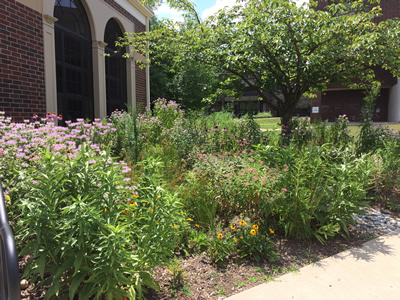Rain Gardens
Highland Park High School
102 North 5th Avenue, Highland Park, Middlesex County, New Jersey
| Google (TM) Map | Site Contact(s) | History | Runoff Managed |
| Installation | Plant Layout | Maintenance | Photographs |
Christopher Obropta, Rutgers Cooperative Extension Water Resources Program
The Highland Park High School rain garden was installed to capture, treat, and infiltrate stormwater runoff from a portion of the school’s roof via two redirected downspouts.
The potential to install a rain garden at Highland Park High School was identified through site assessments that were conducted as part of a grant the Rutgers Cooperative Extension (RCE) Water Resources Program received: “National Fish and Wildlife Foundation ~ Incorporating Green Infrastructure Resiliency in the Raritan River Basin.” A deliverable for the grant included visiting 54 towns within the Raritan River Basin and identifying locations where green infrastructure could be installed.
After meeting with the principal, Michael Lassiter, and proposing the project, he informed us that the school was dedicating their courtyard area to sustainability and that our proposal to install a rain garden in the area would be a great addition. The courtyard has an outdoor classroom, raised bed vegetable gardens, a pollinator garden, and wheat and corn crops. The rain garden was installed adjacent to the cafeteria building to capture runoff from the roof by disconnecting two downspouts from the storm sewer system and redirecting them to release into the rain garden. The rain garden was designed to capture, treat, and infiltrate rain events equivalent to a two-year storm (3.3 inches of rain). For larger storm events, an underdrain was installed to release additional rainwater to the exiting detention basin in the courtyard. The location is ideal to demonstrate to the students what a rain garden is and how it works to enhance wildlife habitat and elevate stormwater runoff issues.
This rain garden manages stormwater runoff from a portion of the school roof through two downspouts which were disconnected from the sewer system and redirected into the rain garden.
This rain garden was designed in the spring of 2016 by Tobiah Horton and installed by Enviroscapes, Inc. An excavator was used to remove approximately 27 cubic yards of native soil. An underdrain was installed, and 12 inches of bioretention soil was added to the base of the rain garden to promote infiltration. Next a three-inch layer of shredded hardwood mulch was added to hinder weeds and retain moisture, leaving a six-inch open ponding area. The inlets were made by disconnecting the downspouts from the storm sewer system. PVC pipe was installed, and fittings were added to connect the PVC pipe to the existing downspouts. The native plants used in this rain garden were installed under the direction of Tobiah Horton by the RCE Water Resources Program staff, interns, and students from the Highland Park Middle School. The plants were purchased from Pinelands Nursery & Supply.
Funding for this project is provided by the Department of the Interior through a grant from the National Fish and Wildlife Foundation’s Hurricane Sandy Coastal Resiliency Competitive Grant Program.
Plant
Layout:
Rain
Garden Map:
Click here for the Highland Park High School design plan
Rain Garden Parameters:
Rain garden size - 300 square feet (annual runoff volume captured – 31,266 gallons)
Drainage area - 1,200 square feet
Plant List:
Beebalm
Blue Lobelia
Blue Mistflower
Canada Goldenrod
Common Elderberry
Orange Coneflower
Purple Coneflower
Soft Rush
Swamp Milkweed
This rain garden is maintained by students and faculty.
Click here for photographs of the Highland Park High School rain garden.
